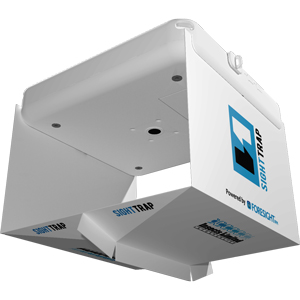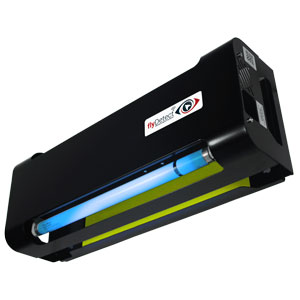Product manufacturers share what’s new — and their five-year forecasts.
We spoke with seven industry suppliers about their strategies and products to assist pest management professionals (PMPs) at stored product pest (SPP) accounts. Read on for their insights and announcements. We also want to know what SPP management methods you’re implementing, and what you hope to add in the near future. Drop us a line at pmpeditor@northcoastmedia.net.
CATCHMASTER

IMAGE: CATCHMASTER
Chris Ernst
Brand Strategy Director
RECENT INNOVATION: Protecting stored products often means covering large areas. And the larger the area, the more time required for a technician in the field. That is why we developed our improved Catch Zone Pest Boundary Roll. Measuring a whopping 60 feet x 12 inches, it is the quickest way to protect large, sensitive areas. Like many of our products, Catch Zone has been improved with feedback from the field. These improvements include adding 300 percent more glue and a heavier paper that lays flat. Warehouses, food processing facilities, supermarkets and storage areas are all ideal placement opportunities.
Ideal for cleanouts and hot spots, Catch Zone traps and controls mice and insects, and is compatible with attractants and pheromones like our 701 Roach Attractant. Use the boundary roll to define a 12-inch-wide pest-free zone around a target area. Install along walls to provide a clear line of sight between walls and pallets to eliminate potential harborage areas. Duct, masking or gaff tape — or our Hercules Putty — provide an easy way to secure when deploying.
PREDICTIONS: With a projected growth rate for SPP control of up to 5 percent annually expected through 2025, we anticipate SPP to continue to become an increased revenue stream for PMPs. We envision organic and natural food trends to continue healthy growth and, as pest management is a key cog in supply chains, we believe non-toxic pest control options will continue to provide PMPs an opportunity to differentiate their service offerings.
FMC

PHOTO: FMC
Sam Pass
Pest Control & Nursery Greenhouse Market Manager
RECENT INNOVATION: FMC offers a portfolio of products for food-handling areas and works to ensure new products, such as the recently introduced Scion insecticide with UVX technology (pictured), include SPP on their labels. Our food-handling portfolio also includes CB-80 insecticide, for flushing and contact, and D-Force insecticide, for up to eight weeks of protection. For SPP control, CB-80 may be sprayed into cracks and crevices, processing and handling equipment, around cartons and containers, and other areas where pests tend to congregate.
When residual control of pests is desired, PMPs can use D-Force insecticide. It contains the active ingredient deltamethrin, and may also be used in restaurants and other food-handling establishments, food processing plants, hospitals, supermarkets, motels and hotels, residences and transportation equipment. When managing SPP in commercial accounts, like food processing plants or restaurants, PMPs should be proactive and employ a monitoring program. When SPP are encountered in residences, PMPs should remove and dispose of infested food products.
PREDICTIONS: SPP continue to be a concern for PMPs, especially those focused on commercial services. At FMC, we continue to develop better solutions to help PMPs grow their businesses. In the future, we expect SPP management to rely increasingly on monitoring and prevention.
INSECTS LIMITED

PHOTO: INSECTS LIMITED
Tom Mueller
Vice President
RECENT INNOVATION: Remote pest monitoring is no longer “an emerging buzzword.” It is here to stay, and companies are using these devices to achieve three things:
- Improve the services they are providing to customers.
- Create new value to existing and potential customers.
- Bring themselves and their services closer to their customers.
The benefits these devices are providing prove valuable to all parties involved. That’s why we created the SightTrap, a remote insect pheromone monitor to help customers working hard to manage SPP infesting commercial food customers’ products and destroying their brands.
The SightTrap is an image-based monitoring device that automatically provides the identification and infestation size of insects in food-related facilities. The device is paired with a glue board containing a pheromone lure, and an image of the glue board is sent to ForesightIPM, a software program that identifies, counts and organizes the insects and data into an easy-to-read dashboard.
This process allows you to know exactly where the problem areas of the facilities are located.
After a threshold has been created and the insect count has exceeded that number, an alert notification informs you and your customer there is a potential problem. The SightTrap will save you time at these accounts, and allow you to provide your customers with the quality, professional service you have promised.
PREDICTIONS: Our pipeline for SPP control is very strong, and our lab has enough to keep them busy for a very long time. I cannot disclose the details just yet, but customers can expect pheromone monitoring devices for new pest insects, as well as ease-of-use devices to help streamline monitor setup processes. You also can rest assured we already are working toward versions 2 and 3 of the SightTrap.
As we look ahead, SPP are not going anywhere. They have been here a lot longer than we have, and will be here a lot longer after we are gone. The industry is going to continue to demand quality pheromone monitoring devices that are easy to use.
PESTWEST USA

IMAGE: PESTWEST
Dr. Stuart Mitchell, BCE
Technical Director
RECENT INNOVATION: The stealthy Indianmeal moth (IMM, Plodia interpunctella) is a pestiferous thief of food products by contamination. Did you know it is one of the most encountered of the indoor stored product pests (SPP)? IMM generally is seen as an adult moth, but it may be seen in the larval form — both crawling away from infested products, and assuming the color of infested products, which can be a hint in locating infested products.
For adult IMM monitoring, use PestWest’s exclusive Demi-Diamond Walk-By Monitoring System with pheromone glue board lure. Additionally, use proper food product rotation practices of last product in, first product out (LIFO); or first product in, first product out (FIFO). You also should destroy infested products, and clean product storage areas.
PestWest also offers the online flying insect monitor flyDetect. Because IMM adults are attracted to long-wave (UVA) light*, flyDetect provides a 24/7/365 remote monitoring system for food processing and many other sensitive environments.
FlyDetect immediately notifies your smartphone app or computer program of flying insect infestations that exceed your set thresholds; you can even customize “red,” “amber” and “green” alert levels. The patent-pending glue board image-capturing process uses a built-in, high-resolution camera, and the monitor records essential diagnostic glue board images, temperature, and humidity data. In addition, flyDetect sends scheduled notifications of UVA lamp and glue board changes, with connectivity options of Wi-Fi, Ethernet or cellular.
PREDICTIONS: With the increasing complexity of food processing systems, SPP will become even more stealthy and pestiferous. To maintain industry standards, mainstreaming remote data logging or remote sensing for real-time infestation point source location will be essential. Such data will provide more accurate trends analyses and root cause analyses to better control and prevent infestation.
* Reference: “Insect Vision: Ultraviolet, Color, and LED Light.” Shockley Cruz, M., and Lindner, R. University of Georgia Department of Entomology, November 2011
ROCKWELL LABS

PHOTO: ROCKWELL LABS
Dr. Cisse Spragins
Founder and CEO
RECENT INNOVATION: CimeXa (pictured) is now labeled for stored product insects, including pantry and fabric beetles and moths. With its very long residual activity, it’s ideal for treating cracks, crevices and voids around commodity storage areas, pantries and closets to eliminate harborage and breeding areas inside the facility.
We also have two innovative and unique gelled oil lures in syringes. InVite Moth Lure Gel contains a pheromone lure for common pantry moths, while InVite Multi-Insect Lure attracts common pantry beetles and moths with a combination of food and pheromone lures. Both gels can be applied to any glue board, in our D-Sect IPM Station, or inside our PFT Yellow Hanging Station.
With the syringe form of the gels, dosage can be adjusted as necessary. For example, use lower amounts of pheromone in residential settings and near doorways in commercial facilities. The gels can also be used to attract pests to insecticide-treated surfaces. A simple and economical pitfall trap for beetles can also be created by applying InVite Multi-Insect Lure Gel inside Rockwell’s BaitPlate Stations.
Looking ahead, an addition to the EcoVia range for treating stored product insects in both conventional and organic food processing areas is in the works.
PREDICTIONS: Fumigation continues to be under scrutiny because of safety and environmental concerns, which will likely result in increased regulation. While we don’t think fumigation will go away, as it is important for food safety, there will be an increased use of innovative and non-fumigation control methods, including treated packaging for food and feed products.
TRÉCÉ

PHOTO: TRÉCÉ
James Miller, ACE
Market Manager, PCO
RECENT INNOVATION: The new industry norm is pre-baited, quick-deploying, multi-attractant pheromone monitoring systems — embodied by Trécé’s own STORGARD Quick-Change WCM+CMCM Combi Kit. The kit targets webbing clothes moths (Tineola bisselliella) and casemaking clothes moths (Tinea pellionella), and is available with STORGARD II or STORGARD III adhesive traps. It has the Combination lure pre-installed (six per kit) for convenience and labor savings. Many larger firms are adopting these “Quick-Change” systems and seeking more education on their proper use.
Also, although it’s more than 15 years old, mating disruption is still a “new” concept for the industry. Each year, more commercial and industrial clients request that their pest management firm deploy a mating disruption program. There are even a few large retail chains that treat every store, up to 1,300 stores.
We always are looking for ways to improve efficacy and early detection, as well as enhance capture rates. While there may not be any earth-shattering new species in the SPP game, improvements are being made. And new mating disruption products are on the way; some of ours currently are in the registration process with the U.S. Environmental Protection Agency.
PREDICTIONS: With food safety regulations and auditing requirements gaining more enforcement powers, PMPs must educate their staff and continue to advance prevention-based IPM. Our future forecast for the SPP segment is a well-trained and prevention-minded pest management industry, able to identify risks and set up IPM programs that prevent first, control later.
ZOËCON PROFESSIONAL PRODUCTS

PHOTO: ZOËCON PROFESSIONAL PRODUCTS
Mel Whitson
Senior Field Technical Service Manager
RECENT INNOVATION: Gentrol Complete Aerosol, from the Gentrol product family, is an ideal solution for PMPs looking for a quick and easy way to control SPP with an extended residual.
Combining the insect growth regulator (IGR) (S)-hydroprene and the adulticide lambda-cyhalothrin, Gentrol Complete Aerosol is great for treating kitchens where sanitation is often a challenge. This contact aerosol features a dissipating foam action to target insects in hard-to-reach spots, like behind stoves and refrigerators.
In addition to controlling SPP, Gentrol Complete Aerosol also controls German cockroaches, ants, drain flies, fruit flies and spiders. The low-odor solution can be used for general surface, crack-and-crevice and spot treatments on stainless steel appliances and in other labeled treatment areas.
PREDICTIONS: Looking ahead, we’re always exploring the chemistry between our IGRs and other active ingredients. The end goal is to make it even easier for PMPs to control pests in food handling areas and other sensitive treatment locations. We also are continuing to explore combination chemistry, as the demand for products to be applied in multiple ways expands.
We see prevention as the future for controlling SPP. We see grain becoming better protected from the field all the way to the pantry. Educating PMPs as well as their customers will play a key role in stopping these infestations.
Leave A Comment